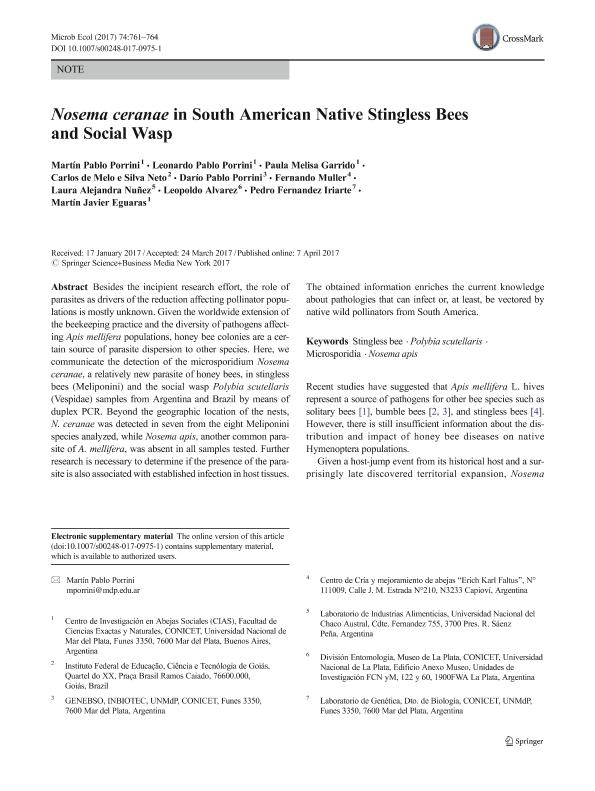Artículo
Nosema ceranae in South American Native Stingless Bees and Social Wasp
Porrini, Martín Pablo ; Porrini, Leonardo Pablo
; Porrini, Leonardo Pablo ; Garrido, Paula Melisa
; Garrido, Paula Melisa ; Melo e Silva Neto, Carlos de; Porrini, Darío Pablo
; Melo e Silva Neto, Carlos de; Porrini, Darío Pablo ; Muller, Fernando; Nuñez, Laura Alejandra; Alvarez, Leopoldo Jesús
; Muller, Fernando; Nuñez, Laura Alejandra; Alvarez, Leopoldo Jesús ; Fernandez Iriarte, Pedro Jose
; Fernandez Iriarte, Pedro Jose ; Eguaras, Martin Javier
; Eguaras, Martin Javier
 ; Porrini, Leonardo Pablo
; Porrini, Leonardo Pablo ; Garrido, Paula Melisa
; Garrido, Paula Melisa ; Melo e Silva Neto, Carlos de; Porrini, Darío Pablo
; Melo e Silva Neto, Carlos de; Porrini, Darío Pablo ; Muller, Fernando; Nuñez, Laura Alejandra; Alvarez, Leopoldo Jesús
; Muller, Fernando; Nuñez, Laura Alejandra; Alvarez, Leopoldo Jesús ; Fernandez Iriarte, Pedro Jose
; Fernandez Iriarte, Pedro Jose ; Eguaras, Martin Javier
; Eguaras, Martin Javier
Fecha de publicación:
04/2017
Editorial:
Springer
Revista:
Microbial Ecology
ISSN:
0095-3628
Idioma:
Inglés
Tipo de recurso:
Artículo publicado
Resumen
Besides the incipient research effort, the role of parasites as drivers of the reduction affecting pollinator populations is mostly unknown. Given the worldwide extension of the beekeeping practice and the diversity of pathogens affecting Apis mellifera populations, honey bee colonies are a certain source of parasite dispersion to other species. Here, we communicate the detection of the microsporidium Nosema ceranae, a relatively new parasite of honey bees, in stingless bees (Meliponini) and the social wasp Polybia scutellaris (Vespidae) samples from Argentina and Brazil by means of duplex PCR. Beyond the geographic location of the nests, N. ceranae was detected in seven from the eight Meliponini species analyzed, while Nosema apis, another common parasite of A. mellifera, was absent in all samples tested. Further research is necessary to determine if the presence of the parasite is also associated with established infection in host tissues. The obtained information enriches the current knowledge about pathologies that can infect or, at least, be vectored by native wild pollinators from South America
Palabras clave:
Stingless Bee
,
Polybia Scutellaris
,
Microsporidia
,
Nosema Apis
Archivos asociados
Licencia
Identificadores
Colecciones
Articulos(CCT - LA PLATA)
Articulos de CTRO.CIENTIFICO TECNOL.CONICET - LA PLATA
Articulos de CTRO.CIENTIFICO TECNOL.CONICET - LA PLATA
Articulos(CCT - MAR DEL PLATA)
Articulos de CTRO.CIENTIFICO TECNOL.CONICET - MAR DEL PLATA
Articulos de CTRO.CIENTIFICO TECNOL.CONICET - MAR DEL PLATA
Citación
Porrini, Martín Pablo; Porrini, Leonardo Pablo; Garrido, Paula Melisa; Melo e Silva Neto, Carlos de; Porrini, Darío Pablo; et al.; Nosema ceranae in South American Native Stingless Bees and Social Wasp; Springer; Microbial Ecology; 74; 4; 4-2017; 761-764
Compartir
Altmétricas



